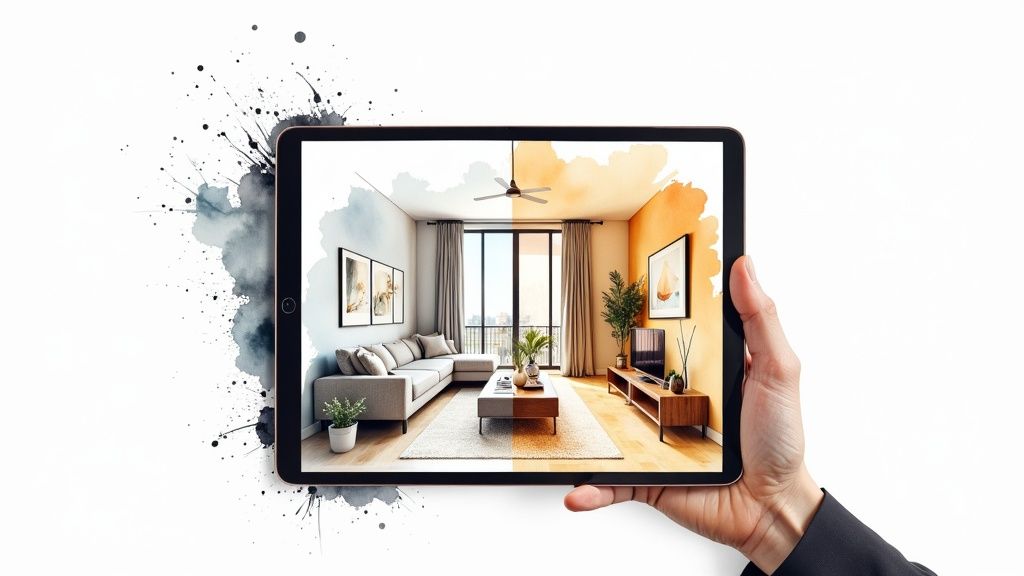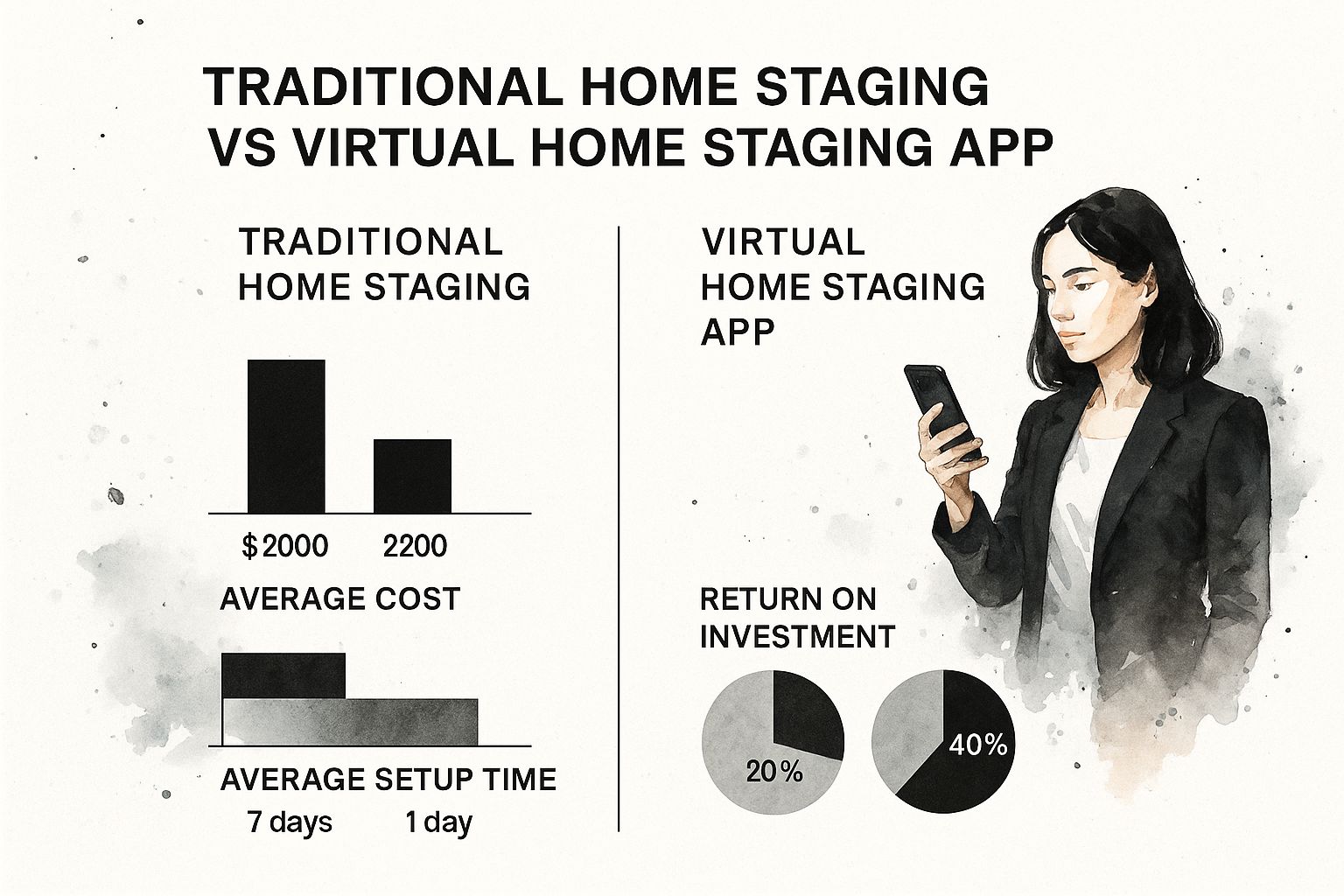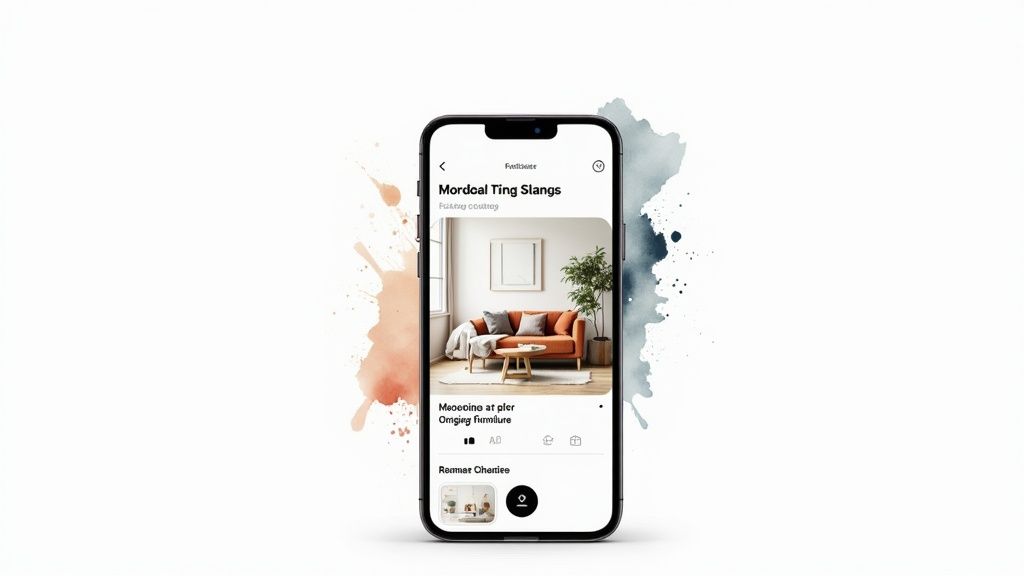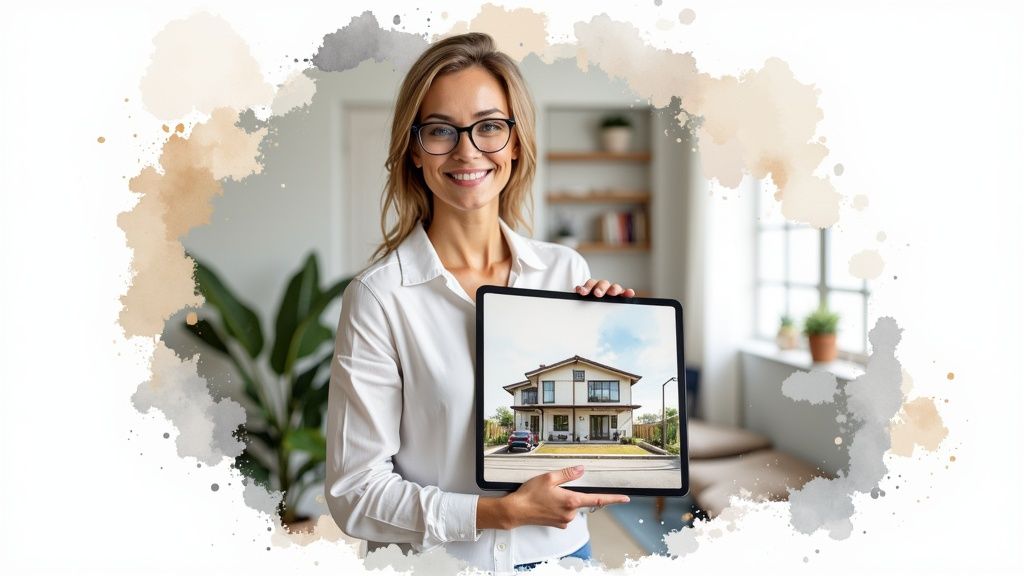Your Guide to the Best Virtual Home Staging App

At its core, a virtual home staging app is a clever piece of software that digitally furnishes and decorates photos of empty or outdated rooms. It’s all about helping potential buyers see a property’s true potential, making those online listings far more compelling.
What Exactly Is a Virtual Home Staging App?
Imagine having a digital interior designer right on your computer. You start with a photo of a vacant living room or a tired-looking kitchen. The app then works its magic, transforming that empty space into a beautifully furnished, move-in-ready home. This process is crucial for bridging the gap between a blank slate and a buyer’s ability to envision themselves living there.
But it’s not just about plopping a 3D model of a couch into a photo. The AI behind these apps is smart enough to analyze a room’s lighting, dimensions, and perspective. This ensures every digital chair, rug, and lamp looks completely natural, complete with realistic shadows and proper scale. To really get a sense of how this works, it helps to understand the wider world of Artificial Intelligence in Photography, which is the engine driving these tools.
A Modern Spin on Real Estate Marketing
This technology is more than just a cool gimmick; it’s genuinely changing how we market properties. The virtual home staging software market is booming, with projections showing it could hit $193.4 million in 2025. This surge is no surprise, given how much real estate has moved online. A strong first impression is everything.
The real power of a virtual home staging app lies in its ability to forge an emotional connection. It helps a buyer fall in love with a property before they even set foot inside, turning a blank canvas into a place they can imagine calling home.
Let’s break down how this digital approach stacks up against the old-school way of doing things.
Virtual Staging vs Physical Staging at a Glance
| Attribute | Virtual Home Staging App | Traditional Physical Staging |
|---|---|---|
| Cost | Significantly lower, often a flat fee per image. | Expensive, involving furniture rental, movers, and designer fees. |
| Time | Fast turnaround, typically within 24-48 hours. | A slow process that can take days or even weeks to complete. |
| Flexibility | Easily change styles, furniture, and color palettes. | Inflexible; once staged, changes are costly and time-consuming. |
| Logistics | Entirely digital, requiring only photos. | Involves heavy lifting, scheduling, and physical access to the property. |
| ROI | High, due to low initial cost and high buyer engagement. | Can be effective, but high costs can eat into the final profit. |
The side-by-side comparison makes it clear: virtual staging offers a much faster, more affordable, and flexible solution.

As you can see, the efficiency and accessibility of a virtual home staging app make it an almost essential tool for any agent or seller looking to make an impact in today’s crowded market. It delivers professional results without the traditional headaches and high costs.
The Unseen Advantages of Virtual Home Staging

Sure, the stunning visuals are the first thing you notice, but the real magic of a virtual home staging app is how it impacts your business. It’s about more than just making empty rooms look good; it’s a strategic tool that delivers real-world results by focusing on three things: cost, speed, and flexibility.
Think about traditional staging for a moment. You’re juggling expensive furniture rentals, coordinating moving crews, and paying hefty designer fees that can quickly run into the thousands. Virtual staging completely changes the game. Instead, you’re looking at a simple per-image fee or an affordable subscription, which cuts marketing costs down to a fraction of the old way.
This financial upside is exactly why the market is booming. The global virtual home staging software market was valued at USD 0.26 billion in 2024 and is expected to hit USD 1.32 billion by 2033. You can dig into more of those numbers over at Business Research Insights.
Accelerate Your Marketing Timeline
Another huge win is speed. Physically staging a property is a long haul—it can easily take weeks from the first consultation to getting the last pillow placed just right. A virtual home staging app shrinks that timeline down to just a few hours.
You can snap photos of an empty house in the morning and have a portfolio of beautifully staged, market-ready images ready to go live that same afternoon.
This quick turnaround means agents and sellers can get properties listed faster, jumping on market opportunities and minimizing how long a home sits empty. It’s all about gaining a competitive edge without sacrificing an ounce of quality.
Unmatched Marketing Flexibility
Maybe the biggest advantage of all is the sheer versatility. Once you’ve moved physical furniture into a home, you’re pretty much locked into one specific look. But what happens when one buyer sees a potential nursery, and another imagines the perfect home office?
With a virtual home staging app, you don’t have to choose. You can create multiple versions of the exact same room to connect with different types of buyers—something that’s flat-out impossible with physical staging.
This kind of digital adaptability is at the heart of modern design technology. We dive deeper into this in our guide on how AI interior design software is pushing these boundaries even further. Of course, knowing the fundamentals helps, too; these 8 Essential Home Staging Tips will give you a solid foundation for applying these virtual tools like a pro.
Essential Features Every Top Staging App Needs
When you’re shopping for a virtual home staging app, it’s easy to get lost in the marketing promises. But what really separates the great tools from the mediocre ones? It comes down to a handful of features that make your life easier and your results look stunningly professional.
It all starts with the furniture library. Think of it as your digital warehouse. A skimpy collection means you’ll end up with cookie-cutter designs that look repetitive and bland. You need a huge, diverse catalog—from sleek modern sectionals to rustic farmhouse tables. Just as important is the quality of the 3D models themselves; they have to look convincingly real, not like something out of a video game.
Of course, having the furniture is one thing. Making it look like it actually belongs in the room is the real trick.
Realistic Rendering and Smart AI
This is where the magic happens. The best apps use powerful AI to generate images that are practically indistinguishable from reality. The software is smart enough to analyze the light in your photo, automatically adding authentic shadows and reflections. Without this, the digital furniture looks like a cheap sticker slapped on an image, instantly shattering the illusion.
Another game-changer is AI-driven style suggestions. Instead of spending hours scrolling for the perfect chair, you can just tell the app you want a “Coastal” or “Industrial” vibe. It will then pull together a curated selection of furniture and decor that fits the look, saving you a ton of guesswork and time.
Smart AI acts like a digital design assistant. It doesn’t just place objects—it guides you toward creating a space that feels thoughtfully and professionally arranged.
Advanced Capabilities and Design Tools
Once you’ve nailed the basics, the more advanced features are what truly set a platform apart and give you a serious marketing edge.
- Virtual Renovations: Go beyond staging and show a property’s true potential. You can digitally swap out old floors, paint walls a new color, or even give the kitchen a full cabinet makeover.
- 360-Degree Tour Integration: Imagine letting buyers walk through a fully staged home from their couch. The best apps let you embed your designs into interactive virtual tours for a completely immersive experience.
- Item Removal: Start with a perfectly clean slate. Some tools can digitally erase existing furniture and clutter from your photos, which is a lifesaver when dealing with occupied homes.
Ultimately, these apps aren’t just about dropping furniture into a picture. They’re about creating compelling, beautiful spaces. Learning a few professional living room furniture arrangement techniques can take your skills to the next level, turning the app from a simple tool into a true design partner. And if you’re curious about similar tools, our deep dive into a virtual room design app offers some great parallel insights.
Seeing the Transformation in Action

It’s one thing to talk about virtual home staging, but it’s another to see it work its magic. The real “aha!” moment comes when you see how this technology can tackle the tricky problems that pop up in real estate all the time.
Think about that small, oddly shaped living room that always leaves buyers scratching their heads. You know the one. With a virtual home staging app, you can drop in a perfect-fit sectional and some smart decor in minutes. Suddenly, the room’s flaws disappear, and buyers can see a cozy, functional space where they can actually imagine living.
Another classic challenge? An outdated kitchen. A room with dated cabinets and tired countertops can be a dealbreaker for a lot of people.
Case Study: A Dated Kitchen Becomes a Modern Masterpiece
Instead of ripping everything out for a costly remodel, an app lets you do a digital facelift. You can virtually “paint” the cabinets a fresh, modern color, swap in some sleek quartz countertops, and hang a few trendy pendant lights. The before-and-after is often stunning, turning a property’s biggest weakness into a major selling point.
This isn’t just about making pretty pictures; it’s driving real business results and changing how the industry operates.
The virtual home staging market is exploding for a reason. Valued at roughly USD 1 billion in 2024, it’s on track to hit USD 2 billion by 2033. This surge shows just how much agents and sellers are relying on digital tools to help buyers connect emotionally with a property. You can dig into more of this data in a report from Business Research Insights.
Every time you stage a room, you’re telling a story. You’re showing a buyer how a small bedroom can still feel spacious, or how that forgotten bonus room could become their new home office. A virtual home staging app is the tool that lets you create that compelling visual narrative, helping you hook buyers and get them through the door.
How to Choose the Right Staging App for You
Picking the right virtual home staging app isn’t about finding the one “best” tool—it’s about finding the best tool for you. What a real estate agent needs to get a dozen listings online quickly is completely different from what an interior designer requires for a high-end client pitch.
Let’s break it down by profession.
For Real Estate Agents: Speed and Simplicity are King
If you’re a busy real estate agent, your main goals are probably speed, ease of use, and cost-effectiveness. You don’t have time for a complicated program; you need to stage multiple properties and get them on the market, fast.
Look for apps with intuitive drag-and-drop controls, maybe some AI-powered style suggestions to get you started. A pay-per-image or an affordable subscription model often makes the most sense for managing a high volume of listings without breaking the bank. The name of the game is getting professional-looking images produced quickly and efficiently.
For Property Developers: Showcasing Potential
Property developers are playing a different game. You’re not just staging a room; you’re selling a vision, sometimes for a property that doesn’t even exist yet. Your needs are far more advanced.
The ideal app for a developer will include powerful features like:
- Virtual Renovations: The ability to show buyers what that dated kitchen could look like with new cabinets or how the living room transforms with hardwood floors.
- Architectural Visualization: Tools that can take a blueprint or 3D model and render a fully furnished, realistic space to wow investors and pre-construction buyers.
For Interior Designers: Curation and Photorealism
Interior designers operate on a whole other level of detail. For you, it’s all about customization and creating a specific, curated aesthetic.
You’ll want an app with a massive library of brand-name furniture and decor so you can build out precise looks. Above all else, the rendering quality has to be flawless. Every shadow, texture, and light reflection needs to be photorealistic enough to present to a client with confidence. For more ideas on integrating tech into your design work, check out other articles on the RoomGenius blog.
Before you commit to an app, stop and ask yourself one simple question: Does this tool actually solve my biggest problem? Answering that honestly will point you straight to the platform that fits your workflow, not one that forces you to change it.
Common Questions About Virtual Home Staging

Whenever a powerful new marketing tool like a virtual home staging app comes along, it’s natural to have questions about how it works, what it costs, and if it’s even ethical. Let’s clear the air and tackle some of the most common concerns head-on.
One of the first questions I always hear is, “Isn’t this just tricking people?” The answer is a hard no—as long as you’re upfront about it. The golden rule is transparency. Every major real estate board and association agrees that you must clearly label any virtually staged photos. The idea isn’t to pull a fast one on buyers; it’s to help them see beyond four empty walls and imagine what their life could look like in that space.
From there, the conversation almost always turns to the price. What’s the real cost?
Breaking Down the Cost
The beauty of virtual staging is that it’s worlds cheaper than traditional staging. We’re talking a tiny fraction of the cost. Most apps and services fall into one of two pricing structures:
- Pay-Per-Photo: This is a popular route, especially for one-off projects. You can expect to pay anywhere from $15 to $75 per photo, depending on how much detail you want.
- Monthly Subscriptions: For agents or investors doing higher volume, subscriptions make a lot of sense. These plans typically run from $20 to $100 a month and often come with a certain number of included images or unlimited access.
When you think about the thousands of dollars it costs to rent furniture, pay for movers, and hire a physical stager, the math is pretty simple. Virtual staging opens up professional-quality marketing to a much wider audience.
Ethical virtual staging is all about showcasing possibilities, not misrepresenting reality. By clearly marking images as “virtually staged,” you maintain trust while giving buyers a reason to get excited about the space.
Do I Need to Be a Designer?
This is probably the most practical question of all: Do you need an eye for design to make this work? Not at all. Seriously. The best virtual staging apps are built for real estate pros and homeowners, not professional designers.
They’re designed to be incredibly intuitive, with simple drag-and-drop tools and smart AI that figures out the tricky stuff like lighting, shadows, and furniture scale for you. The whole point is to let you create stunning, professional results without needing any special skills or a long learning curve.
Ready to transform your property photos in minutes? RoomGenius uses powerful AI to make interior design simple and accessible for everyone. Stage your space, explore new styles, and find the perfect furniture—all with just a few clicks. Start your design journey at https://www.room-genius.com.